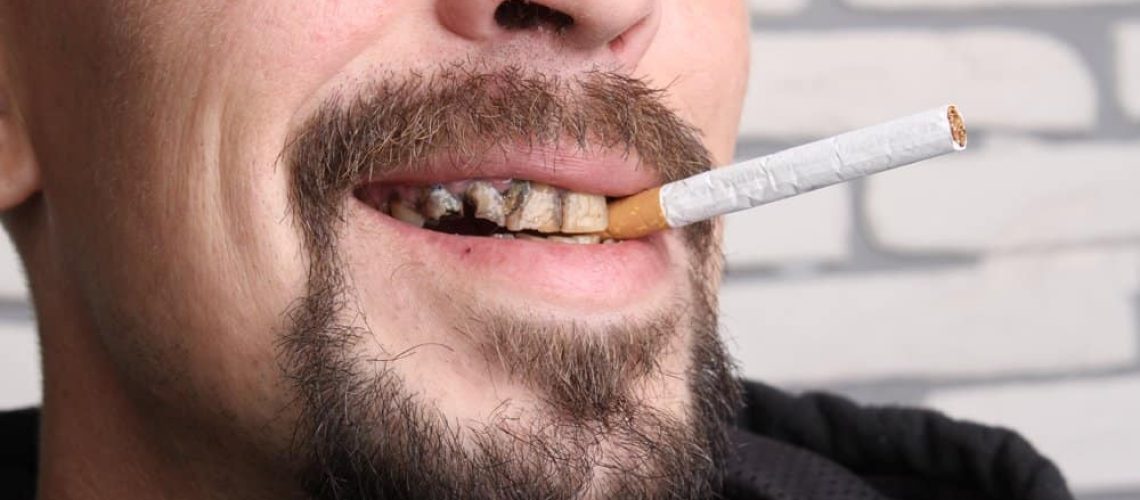Your Idaho Falls dentists at Comfort Care and our staff of dental professionals are concerned about the effects of smoking and the use of tobacco on your oral health. Everyone knows smoking is bad for your health, but did you know it is a major contributor to dental problems as well? The effect of smoking on teeth and oral health is important information if you are a smoker. According the the American Dental Association, smoking and tobacco use can cause stained teeth, bad breath, and a diminished sense of taste. Smoking also lowers your immune system and is one of the most significant risk factors associated with gum or periodontal disease, and tooth loss. Also, the use of tobacco, especially smokeless (chewing) tobacco, increases your risk of oral cancer. The effects of smoking can also lead to tooth decay and this poses a challenge with restorative dentistry as tobacco causes tooth discoloration, the results of treatment are not always ideal. In addition, gum recession can cause uneven margins on crowns and other restorations.
Smokeless Tobacco
Smokeless tobacco comes in many different forms and is called by many different names including: chewing tobacco; spit tobacco; dip; snuff; and snus. Snus is a Swedish type of smokeless tobacco that comes in pouches that a user puts between the upper lip and gum for about 30 minutes and then discards without spitting. This has become very popular in America because it is not as messy as chewing tobacco, dipping tobacco and moist tobacco because it does not cause excessive saliva during use. It does, however, still contain all the active ingredients of chewing tobacco.
America is called snus (rhymes with “goose”). It’s a Swedish type of smokeless tobacco that comes in tea bag-like pouches that a user sticks between the upper lip and gum for up to 30 minutes and discards without spitting. This form of smokeless tobacco has become more popular because it’s not as messy as chewing tobacco, dipping tobacco and moist snuff, which often cause excess saliva during use. It does, however, still contain the active ingredients of chewing tobacco. These forms of smokeless tobacco are not harmless when it comes to oral health. Some of the risks smokeless tobacco carries are:
- Bad breath
- Teeth discoloration
- Decreased sense of smell and taste
- High risk of developing cavities, made even higher with sugar added to many of these products to improve taste and popularity
Just like cigarettes, smokeless tobacco leads to higher risks and higher frequency of oral cancer. Some of the other known health dangers of smokeless tobacco are:
- Smokeless tobacco products, just like cigarettes, contain at least 28 cancer-causing chemicals.
- Smokeless tobacco is known to cause cancers of the mouth, lip, tongue and pancreas.
- Users also may be at risk for cancer of the voice box, esophagus, colon and bladder, because they swallow some of the toxins in the juice created by using smokeless tobacco.
- Smokeless tobacco can irritate your gums, causing gum (periodontal) disease.
- Smokeless tobacco typically contains sand and grit, which can wear down teeth, causing tooth sensitivity and erosion.
Quit Tobacco Use
Of course, your Idaho Falls dentists at Comfort Care Dental are here to help you in your efforts to eliminate the use of tobacco for the health of your teeth, your mouth and your body. Five important tips for quitting tobacco use are these:
- It is never too late to quit. While it’s best to quit smoking as early as possible, quitting smoking at any age will enhance the length and quality of your life (and your oral health). You can even inspire those around you to quit smoking!
- Learn from past experiences. Most smokers have tried to quit before and sometimes people get discouraged thinking about previous attempts. Think about what helped you during those tries and what you’ll do differently this time.
- You don’t have to quit alone. Telling friends and family that you’re trying to quit and getting their support will help ease the process. Expert help is available from the American Lung Association and the American Dental Association.
- Medication can help and your doctor or dentist is ready to help with the medication you may need. The seven FDA-approved medications (like nicotine patches or gum) really do help smokers quit. Follow the instructions for use exactly for optimum results.
- Every tobacco user can quit. We firmly believe that every smoker can quit. Each person needs to find the right combination of techniques for them and above all, they need to keep trying.






